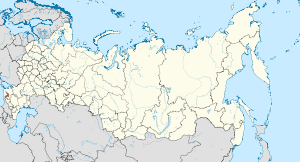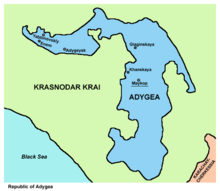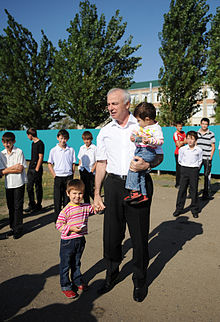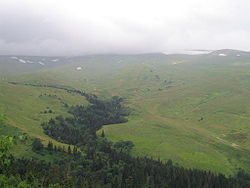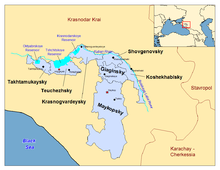- Adygea
-
"Adygea" redirects here. For other uses, see Adygea (disambiguation).
Republic of Adygea Республика Адыгея (Russian)
Адыгэ Республик (Adyghe)— Republic — 
Flag
Coat of armsAnthem: Anthem of the Republic of Adygea Coordinates: 44°39′N 40°00′E / 44.65°N 40°ECoordinates: 44°39′N 40°00′E / 44.65°N 40°E Political status Country Russia Federal district Southern[1] Economic region North Caucasus[2] Established July 27, 1922[3] Capital Maykop[4] Government (as of March 2010) - Head[5] Aslan Tkhakushinov[6] - Legislature State Council (Khase)[5] Statistics Area (as of the 2002 Census)[7] - Total 7,600 km2 (2,934.4 sq mi) Area rank 80th Population (2010 Census)[8] - Total 440,388 - Rank 74th - Density 57.95 /km2 (150.1 /sq mi) - Urban 51.0% - Rural 49.0% Population (2002 Census)[9] - Total 447,109 - Rank 74th - Density 58.83 /km2 (152.4 /sq mi) - Urban 52.5% - Rural 47.5% Time zone(s) MSD (UTC+04:00)[10] ISO 3166-2 RU-AD License plates 01 Official languages Russian;[11] Adyghe[12] http://www.adygheya.ru/ The Republic of Adygea (English pronunciation: /ɑːdɨˈɡeɪ.ə/;[13] Russian: Респу́блика Адыге́я, tr. Respublika Adygeya, IPA: [ɐdɨˈɡʲejə]; Adyghe: Адыгэ Республик, Adıge Respublik) is a federal subject of Russia (a republic) enclaved within Krasnodar Krai. Its area is 7,600 square kilometers (2,900 sq mi) with a population of 440,388 (preliminary 2010 Census results).[8] Its capital is Maykop.
Contents
Geography
Adygea lies in southeastern Europe in the northern foothills of the Caucasus Mountains, with plains in the north and mountains in the south. Forests cover almost 40% of its territory.
- Area: 7,600 km2 (2,900 sq mi)
- Borders: Adygea is entirely surrounded by Krasnodar Krai
- Highest point: Chugush Mountain 3,238 m (10,623 ft)
Rivers
The 870-kilometer (540 mi) long Kuban River is one of the major navigable rivers in the Caucasus region. It forms part of the northern border between Adygea and Krasnodar Krai. Other rivers include:
- Belaya River
- Chokhrak River
- Dakh River
- Fars River
- Khodz River
- Kisha River
- Bolshaya Laba River (forming part of the eastern border between Adygea and Krasnodar Krai)
- Psekups River
- Pshish River
- Sakhray River
- Sukhoy Kurdzhips River, which flows near the archaeological site at Mezmaiskaya cave[14]
Lakes
The republic has no large lakes. However, the several large reservoirs include:
- Krasnodarskoye Reservoir
- Oktyabrskoye Reservoir
- Shapsugskoye Reservoir
- Tshchitskoye Reservoir
Mountains
The republic's major mountains range in height from 2,000 to 3,238 m and include:
- Chugush Mountain 3,238 m (10,623 ft)
- Mount Fisht 2,868 m (9,409 ft)
- Oshten Mountain
- Pseashkho Mountain
- Shepsi Mountain
Natural resources
The republic is rich in oil and natural gas. Other natural resources include gold, silver, tungsten, and iron.
Climate
- Average January temperature: −0.5 °C (31.1 °F)
- Average July temperature: 23 °C (73 °F)
- Average annual precipitation: 70 centimeters (28 in)
History
The Adyghe people, sometimes known as Circassians, were the ancient dwellers of the North-West Caucasus since the 13th century.
Cherkess (Adyghe) Autonomous Oblast was established within the Russian SFSR on July 27, 1922, on the territories of Kuban-Black Sea Oblast, primarily settled by the Adyghe people. At that time, Krasnodar was the administrative center. It was renamed Adyghe (Cherkess) Autonomous Oblast on August 24, 1922, soon after its creation. In the first two years of its existence the autonomous oblast was a part of the Russian SFSR, but on October 17, 1924, it was transferred to the jurisdiction of the newly created North Caucasus Krai within the RSFSR.[15]
It was renamed Adyghe Autonomous Oblast (AO) in July 1928. On January 10, 1934, the autonomous oblast became part of new Azov-Black Sea Krai, which was removed from North Caucasus Krai. Maykop was made the administrative center of the autonomous oblast in 1936. Adyghe AO became part of Krasnodar Krai when it was established on September 13, 1937.
On July 3, 1991, the oblast was elevated to the status of a republic under the jurisdiction of the Russian Federation. The first President of the republic was Aslan Aliyevich Dzharimov, elected in January 1992. From 2002 to 2007, Hazret Sovmen was President. He, and most of the rest of the political elite in Adygea, are Adyghes. As a reaction to that, an organization calling itself the Union of Slavs was established, claiming that ethnic Russians are discriminated against in Adygea. They advocate the merger of Adygea with Krasnodar Krai, but have so far have had little support for that proposition from the Russian government.
Politics
The head of the government in Adygea is the Head (called "President" until May 2011), who is appointed for a five-year term. Proficiency in the Adyghe language is a prerequisite for the candidate.[16]
The current Head, Aslan Tkhakushinov (since January 13, 2007), succeeded Hazret Sovmen, appointed by Vladimir Putin, although he received only 2% of the vote in 2002.[17] There is also a directly elected State Council (Khase or Xase—not to be confused with the Adyghe Khase, a union of Adyghe who supported Sovmen for a second term), which comprises the Council of Representatives and the Council of the Republic. Both councils are elected every five years and have 27 deputies each.
The republic sends three representatives to the parliament of the Russian Federation; one to the State Duma and the other two to the Federation Council.
The Constitution of the Republic of Adygea was adopted on May 14, 1995.
Divisions
Main article: List of administrative and municipal divisions of the Republic of AdygeaThe Republic of Adygea is administratively divided into seven districts (raions), two cities/towns, and five urban-type settlements. Municipally, the republic is divided into two urban okrugs, five urban settlements, and 46 rural settlements.
Demographics
- Population: 447,109 (2002)
- Urban: 234,900 (52.5%)
- Rural: 212,209 (47.5%)
- Male: 208,019 (46.5%)
- Female: 239,090 (53.5%)
- Females per 1000 males: 1,149
- Average age: 37 years
- Urban: 36.6 years
- Rural: 37.4 years
- Male: 34 years
- Female: 39.6 years
- Number of households: 151,597 (with 440,449 people)
- Urban: 82,949 (with 230,286 people)
- Rural: 68,648 (with 210,163 people)
Vital statistics
- Source:[18]
Births Deaths Birth rate Death rate 1970 5,681 3,307 14.7 8.6 1975 5,900 3,907 14.9 9.9 1980 6,610 4,828 16.2 11.8 1985 6,966 5,283 16.5 12.5 1990 6,171 5,375 14.2 12.3 1991 5,912 5,905 13.5 13.5 1992 5,306 5,969 12.0 13.5 1993 4,774 6,662 10.7 14.9 1994 4,907 6,519 10.9 14.5 1995 4,798 6,475 10.7 14.4 1996 4,625 6,382 10.3 14.2 1997 4,430 6,302 9.8 14.0 1998 4,340 6,245 9.6 13.9 1999 3,879 6,215 8.6 13.8 2000 4,071 6,710 9.1 15.0 2001 4,212 6,566 9.4 14.7 2002 4,540 6,715 10.2 15.0 2003 4,634 6,929 10.4 15.5 2004 4,648 6,645 10.4 14.9 2005 4,550 6,726 10.3 15.2 2006 4,606 6,686 10.4 15.1 2007 5,210 6,454 11.8 14.6 2008 5,601 6,558 12.7 14.8 Ethnic groups
- According to the 2002 Census,[9] ethnic Russians make up 64.5% of the republic's total population, while the ethnic Adyghe are only 24.2%. Other groups include Armenians (3.4%), Ukrainians (2.0%), Kurds (3,631, or 0.8%), Tatars (2,904, or 0.7%), and a host of smaller groups, each less than 0.5% of the population.
1926 census 1939 census 1959 census 1970 census 1979 census 1989 census 2002 census Adyghe 50,821 (44.8%) 55,048 (22.8%) 65,908 (23.2%) 81,478 (21.1%) 86,388 (21.4%) 95,439 (22.1%) 108,115 (24.2%) Russians 29,102 (25.6%) 171,960 (71.1%) 200,492 (70.4%) 276,537 (71.7%) 285,626 (70.6%) 293,640 (68.0%) 288,280 (64.5%) Armenians 738 (0.7%) 2,348 (1.0%) 3,013 (1.1%) 5,217 (1.4%) 6,359 (1.6%) 10,460 (2.4%) 15,268 (3.4%) Ukrainians 26,405 (23.3%) 6,130 (2.5%) 7,988 (2.8%) 11,214 (2.9%) 12,078 (3.0%) 13,755 (3.2%) 9,091 (2.0%) Others 6,415 (5.7%) 6,313 (2.6%) 7,289 (2.6%) 11,198 (2.9%) 13,939 (3.4%) 18,752 (4.3%) 26,355 (5.9%) Economy
Even though it is now one of the poorest parts of Russia, the republic has abundant forests and rich soil. The region is famous for producing grain, sunflowers, tea, tobacco, and other produce. Hog and sheep breeding are also developed.
Food, timber, woodworking, pulp and paper, heavy engineering, and metal-working are the most developed industries.
Transportation
There is a small airport in Maykop (ICAO airport code URKM). Several rail lines pass through the republic.
Culture
The Adyghe language (Adyghabze) is a member of the Northwest Caucasian group of Caucasian languages. Along with Russian, Adyghe is the official language of the republic.
There are 8 state and 23 public museums in the republic. The largest museum is the National Museum of the Republic of Adygea in Maykop.
Education
Adyghe State University and Maykop State Technological University, both in the capital Maykop, are the two major higher education facilities in Adygea.
Religion
The greater majority of the Republic of Adygea are adherents to Orthodoxy, with an estimated 70% of the population being Orthodox Christians.
25% of the Republic's population are adherents of Islam
Ethnically, most of the Adygeans are Sunni Muslims.
See also
References
- ^ Президент Российской Федерации. Указ №849 от 13 мая 2000 г. «О полномочном представителе Президента Российской Федерации в федеральном округе». Вступил в силу 13 мая 2000 г. Опубликован: "Собрание законодательства РФ", №20, ст. 2112, 15 мая 2000 г. (President of the Russian Federation. Decree #849 of May 13, 2000 On the Plenipotentiary Representative of the President of the Russian Federation in a Federal District. Effective as of May 13, 2000).
- ^ Госстандарт Российской Федерации. №ОК 024-95 27 декабря 1995 г. «Общероссийский классификатор экономических регионов. 2. Экономические районы», в ред. Изменения №5/2001 ОКЭР. (Gosstandart of the Russian Federation. #OK 024-95 December 27, 1995 Russian Classification of Economic Regions. 2. Economic Regions, as amended by the Amendment #5/2001 OKER. ).
- ^ Azarenkova et al., p. 154
- ^ http://www.kommersant.com/p-88/r_432/Republic_of_Adygea/
- ^ a b Constitution, Article 7.4.
- ^ Official website of the Republic of Adygea. Aslan Kitovich Tkhakushinov
- ^ Федеральная служба государственной статистики (Federal State Statistics Service) (2004-05-21). "Территория, число районов, населённых пунктов и сельских администраций по субъектам Российской Федерации (Territory, Number of Districts, Inhabited Localities, and Rural Administration by Federal Subjects of the Russian Federation)" (in Russian). Всероссийская перепись населения 2002 года (All-Russia Population Census of 2002). Federal State Statistics Service. http://perepis2002.ru/ct/html/TOM_01_03.htm. Retrieved 2011-11-01.
- ^ a b Федеральная служба государственной статистики (Federal State Statistics Service) (2011). "Предварительные итоги Всероссийской переписи населения 2010 года (Preliminary results of the 2010 All-Russian Population Census)" (in Russian). Всероссийская перепись населения 2010 года (All-Russia Population Census of 2010). Federal State Statistics Service. http://www.perepis-2010.ru/results_of_the_census/results-inform.php. Retrieved 2011-04-25.
- ^ a b Федеральная служба государственной статистики (Federal State Statistics Service) (2004-05-21). "Численность населения России, субъектов Российской Федерации в составе федеральных округов, районов, городских поселений, сельских населённых пунктов – районных центров и сельских населённых пунктов с населением 3 тысячи и более человек (Population of Russia, its federal districts, federal subjects, districts, urban localities, rural localities—administrative centers, and rural localities with population of over 3,000)" (in Russian). Всероссийская перепись населения 2002 года (All-Russia Population Census of 2002). Federal State Statistics Service. http://www.perepis2002.ru/ct/doc/1_TOM_01_04.xls. Retrieved 2010-03-23.
- ^ Правительство Российской Федерации. Постановление №725 от 31 августа 2011 г. «О составе территорий, образующих каждую часовую зону, и порядке исчисления времени в часовых зонах, а также о признании утратившими силу отдельных Постановлений Правительства Российской Федерации». Вступил в силу по истечении 7 дней после дня официального опубликования. Опубликован: "Российская Газета", №197, 6 сентября 2011 г. (Government of the Russian Federation. Resolution #725 of August 31, 2011 On the Composition of the Territories Included into Each Time Zone and on the Procedures of Timekeeping in the Time Zones, as Well as on Abrogation of Several Resolutions of the Government of the Russian Federation. Effective as of after 7 days following the day of the official publication).
- ^ Official the whole territory of Russia according to Article 68.1 of the Constitution of Russia.
- ^ Constitution of Adygea, Article 5
- ^ "Adygeya at merriam-webster.com". m-w.com. http://www.merriam-webster.com/dictionary/Adygeya. Retrieved 2009-09-23.
- ^ Baryshnikova, Gennady; John F. Hoffeckerb, Robin L. Burgess (May 1996). "Palaeontology and Zooarchaeology of Mezmaiskaya Cave (Northwestern Caucasus, Russia)". Abstract. Journal of Archaeological Science Volume 23, Issue 3, 1996. pp. 313–335. doi:10.1006/jasc.1996.0030. http://www.sciencedirect.com/science?_ob=ArticleURL&_udi=B6WH8-45N4V4D-1F&_user=10&_coverDate=05%2F31%2F1996&_rdoc=1&_fmt=high&_orig=gateway&_origin=gateway&_sort=d&_docanchor=&view=c&_searchStrId=1663207799&_rerunOrigin=google&_acct=C000050221&_version=1&_urlVersion=0&_userid=10&md5=18aaefe624dbf4b21f45e032c44bb25d&searchtype=a. Retrieved 3 March 2011. "Over 6000 large mammal and numerous small vertebrate remains have been recovered from preliminary excavations at Mezmaiskaya Cave"
- ^ под ред. М. Макфола и Н. Петрова (1998). ""Политический альманах России 1997. Том 2. Социально-политические портреты регионов" (Political Almanac of Russia 1997. Vol. 2. Social and Political Portraits of the Regions), online edition" (in Russian). Московский Центр Карнеги. Archived from the original on 2007-06-30. http://web.archive.org/web/20070630091806/http://www.carnegie.ru/ru/pubs/books/volume/218103adygeya.pdf. Retrieved 2007-04-17.
- ^ Казенин, Константин (2009) (in Russian). "ТИХИЕ" КОНФЛИКТЫ НА СЕВЕРНОМ КАВКАЗЕ. Moscow: Regnum. p. 17. ISBN 9785911500306.
- ^ Tsvetkov, Oleg. "Transitions Online: Friends in High Places". CZ: Tol. http://www.tol.cz/look/TOL/article.tpl?IdLanguage=1&IdPublication=4&NrIssue=226&NrSection=1&NrArticle=18839. Retrieved 2010-08-20.
- ^ Russian Federal State Statistics Service
Sources
- Государственный Совет — Хасэ Республики Адыгея. 10 марта 1995 г. «Конституция Республики Адыгея», в ред. Конституционного закона №1 от 20 апреля 2011 г «О поправках в Конституцию Республики Адыгея». Опубликован: "Ведомости ЗС (Хасэ) — Парламента РА", №16, 6–10 марта 1995 г. (State Council of the Republic of Adygea. March 10, 1995 Constitution of the Republic of Adygea, as amended by the Constitutional Law #1 of April 20, 2011 On Amending the Constitution of the Republic of Adygea. ).
- Азаренкова, А. С.; И. Ю. Бондарь, Н. С. Вертышева (1986) [1986] (in Russian). Основные административно-территориальные преобразования на Кубани (1793–1985 гг.). Краснодарское книжное издательство. p. 394.
External links
- Адыгэ Республикэм и Лъэпкъ театр (in Adyghe)
- The Voice of Circassians(Adyghe Language)
- (Russian) Official website of the Republic of Adygea
- (English) Overview of the Republic of Adygea (Kommersant newspaper)
- (English) Official Website of the Adyghe State University
- (Russian) Official Website of the Adyghe State University
- (Russian) Official Website of the National Museum of the Republic of Adygea
- (English) Adygea republic nature sceneries
Subdivisions of Russia Republics Krais Oblasts - Amur
- Arkhangelsk
- Astrakhan
- Belgorod
- Bryansk
- Chelyabinsk
- Irkutsk
- Ivanovo
- Kaliningrad
- Kaluga
- Kemerovo
- Kirov
- Kostroma
- Kurgan
- Kursk
- Leningrad
- Lipetsk
- Magadan
- Moscow
- Murmansk
- Nizhny Novgorod
- Novgorod
- Novosibirsk
- Omsk
- Orenburg
- Oryol
- Penza
- Pskov
- Rostov
- Ryazan
- Sakhalin
- Samara
- Saratov
- Smolensk
- Sverdlovsk
- Tambov
- Tomsk
- Tula
- Tver
- Tyumen
- Ulyanovsk
- Vladimir
- Volgograd
- Vologda
- Voronezh
- Yaroslavl
Federal cities Autonomous oblasts Autonomous okrugs 1administratively subordinated to Tyumen Oblast 2 administratively subordinated to Arkhangelsk Oblast
Countries and regions of the Caucasus History of Europe Prehistoric Europe Classical Antiquity Classical Greece · Roman Republic · Hellenistic period · Roman Empire · Late Antiquity · Early Christianity · Crisis of the 3rd century · Fall of the Roman EmpireMiddle Ages Early Middle Ages · Migration Period · Byzantine Empire · Christianization · Kievan Rus · High Middle Ages · Holy Roman Empire · Crusades · Feudalism · Late Middle Ages · Hundred Years' War · RenaissanceEarly Modern Europe Reformation · Age of Discovery · Baroque · Thirty Years' War · Absolutism · Ottoman Empire · Portuguese Empire · Spanish Empire · Early modern France · Polish–Lithuanian Commonwealth · Swedish Empire · Dutch Republic · British Empire · Habsburg Empire · Russian EmpireModern history See also Politics of Europe Sovereign
states- Albania
- Andorra
- Armenia
- Austria
- Azerbaijan
- Belarus
- Belgium
- Bosnia and Herzegovina
- Bulgaria
- Croatia
- Cyprus
- Czech Republic
- Denmark
- Estonia
- Finland
- France
- Georgia
- Germany
- Greece
- Hungary
- Iceland
- Ireland
- Italy
- Kazakhstan
- Latvia
- Liechtenstein
- Lithuania
- Luxembourg
- Macedonia
- Malta
- Moldova
- Monaco
- Montenegro
- Netherlands
- Norway
- Poland
- Portugal
- Romania
- Russia
- San Marino
- Serbia
- Slovakia
- Slovenia
- Spain
- Sweden
- Switzerland
- Turkey
- Ukraine
- United Kingdom
- (England
- Northern Ireland
- Scotland
- Wales)
- Vatican City
States with limited
recognition- Abkhazia
- Kosovo
- Nagorno-Karabakh
- Northern Cyprus
- South Ossetia
- Transnistria
Dependencies
and other territories- Åland
- Faroe Islands
- Gibraltar
- Guernsey
- Jan Mayen
- Jersey
- Isle of Man
- Svalbard
Other entities - European Union
Categories:- Republic of Adygea
- States and territories established in 1991
Wikimedia Foundation. 2010.

